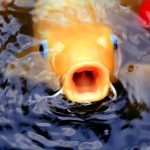Many pond owners have backyard water gardens because they enjoy the beautiful colorful living jewels of the water feature, the fish. Often times keeping koi and goldfish can become an obsessive and fun hobby. It starts with picking out your favorite colors then naming your new pets and soon they are considered part of the family.
In order to keep a happy healthy home for your new pets it’s important to have a little understanding of how to properly care for your finned friends.
History of Koi
It was in Eastern Asia and China where the earliest written records of koi were discovered. These records date back around 2,5000 years ago. Koi or Carp are naturally a brown plain coloration. It was only a few hundred years ago where mutations in color were discovered. These color mutated koi were then bred for their colorations and patterns and the and the hobby of koi-keeping was created in the 20th century.
Shortly after, koi keeping spread to the UK and North America and the hobby continued to grow as more and more koi farms and breeders appeared. To this day Japan is still considered the Koi capital of the world and where many of the most beautiful colorations and patterns stem from.
Feeding Koi
One of the biggest mistakes pond owners make is overfeeding the fish. Fish will consume more than they need but this can be harmful to them as well as it negatively alters the ecosystem. With the increase in food consumption comes an increase in waste, this will increase ammonia and nitrites causing excessive algae growth.
It is also important to understand that when temperatures drop below 50 degrees fahrenheit to NOT feed the fish. At this time the fish’s metabolism slows down and the fish are unable to efficiently digest the food they consume. This could cause sickness or even kill the fish.
Solution to overfeeding-only feed what they can eat in a matter of 3-5 minutes once or twice a day.
In reality, the fish can live off the pond and it is not super important to feed everyday. The added vitamins and nutrients in manufactured fish food can however increase the health and bring out the colorations in Koi and goldfish.
A higher end fish food will also be used more efficiently by the fish as there are less fillers which creates less waste from the fish.
Myth: Fish will increase pond maintenance.
Truth: Fish are a vital part of a good quality pond ecosystem. Koi, especially 10″ and up will reduce algae by feeding on it, I call them “Pond Goats”. They will also fertilize plants with their waste giving you more vibrant blooms in your waterlilies. So the truth is, fish reduce pond maintenance.
Myth: Koi cannot live in a pond with rocks and gravel.
Truth: This is an old school Koi keeper myth. Koi, or carp, are river fish where rocks and gravel cover almost everything. “Aquascape designed ponds”, which house perfectly happy and healthy koi, are always lined with rock and gravel. This also protects the liner from UV light and the Koi love to root around in the gravel for snacks.
Myth: I’ll lose all my fish to predators.
Truth: If constructed properly, the risk of predators can be eliminated. Installing a simple fish cave in your pond will provide areas of safe refuge for fish. Pond plants like water lilies and marginal plants also create cover and places of safety for your koi.
Myth: Koi need at least three feet of water to survive.
Truth: It is recommended to install ponds that are two feet deep in the center. This depth allows the fish to survive through the winter months in cold Upstate NY zone 5 Winters.
Myth: I don’t want the trouble of bringing fish inside for the winter.
Truth: No one does, Koi and are extremely hardy fish, whose ancestors over-wintered in freezing conditions in the mountains of Niigata Japan, and still do. TO over winter your Koi, keep the water circulating with a bubbler pump or and maintain a hole in the ice with a floating heater and they should winter over fine.
Myth: I don’t want to spend thousands of dollars on koi.
Truth: I don’t blame you, you can start with low pet quality koi for as little as $5 each, “Show Quality Koi” go for hundreds of dollars or more.
So now that you have learned a little more about these colorful beauties, don’t be afraid to add them to your pond. They will provide you with plenty of joy and bring your water feature to life!



















